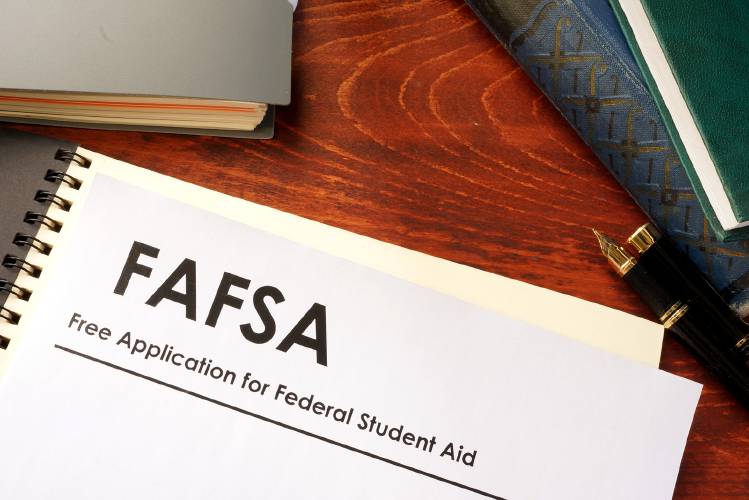Goodbye sibling discount: Colleges grapple with tuition spikes for some families following FAFSA formula change

California has extended its deadline for students to complete their Free Application for Federal Student Aid, or FAFSA. (Dreamstime/TNS) Dreamstime
| Published: 07-27-2024 11:18 AM |
Last month, Kim DeRego, the vice president of enrollment at the University of New Hampshire, received a call from the mother of two UNH students. Her fall tuition bill, the mother told DeRego, was slated to go up $20,000.
The staggering jump was due to a change in the formula used to calculate a family’s expected contribution, the amount the federal government determines a family can afford to pay for their child’s higher education tuition.
Until this year, that formula accounted for the number of children a family had currently enrolled in college. Now it does not.
Under the previous system, if a family with two children in college had an expected family contribution of $20,000, it would be expected to pay roughly $10,000 of each child’s tuition bill. Under the new system, that family’s expected contribution does not get divided: a $20,000 expected family contribution would apply to both children, totaling $40,000 for the family.
Amid the Department of Education’s botched rollout of the revamped Free Application for Federal Student Aid, it is a seismic change that has thus far largely flown under the radar. But that may now be changing: Many colleges in New Hampshire send out fall tuition bills this month with due dates in August.
“We are bracing ourselves for an influx of calls as families really start to focus on those bills,” said Kim DeRego, the vice president of enrollment at the University of New Hampshire, which has an Aug. 1 due date for fall tuition.
Approximately 34% of students enrolled at four-year colleges have siblings, estimated Phillip Levine and Jill Desjean, authors of a Brookings report on the likely effects of the new FAFSA system. The elimination of the sibling discount will affect some subset of that population, though it’s challenging to determine exactly how large that subset will be, Levine, an economics professor at Wellesley College, said in an interview. Families who make below a certain poverty threshold will still receive full Pell grants, while families that make above a certain amount would not have received any aid under the old system anyway.
The U.S. Department of Education did not respond to a question about how many students would see a higher aid bill under the new system than they would have under the previous system.
Article continues after...
Yesterday's Most Read Articles
 New Hampshire legalizes public alcohol consumption in designated ‘social districts’
New Hampshire legalizes public alcohol consumption in designated ‘social districts’
 State rules Epsom must pay open-enrollment tuition to other school districts, despite its refraining from the program
State rules Epsom must pay open-enrollment tuition to other school districts, despite its refraining from the program
 Town turmoil: Chichester town administrator resigns again
Town turmoil: Chichester town administrator resigns again
 New Hampshire providers brace for Medicaid changes that reach beyond healthcare
New Hampshire providers brace for Medicaid changes that reach beyond healthcare
 Warner town administrator granted restraining order against selectman
Warner town administrator granted restraining order against selectman
 NH judge decides to pause Trump’s birthright citizenship order
NH judge decides to pause Trump’s birthright citizenship order
Nonetheless, it’s “a big change,” said Elizabeth Keuffel, the assistant vice president for enrollment and director of financial aid at Saint Anselm College. “I would say probably 20-25% of our returning student population will get their bill and say, ‘Oh, my gosh, why is it so expensive?’”
The change – which stems from a federal law passed in 2020 that was intended to simply the FAFSA application process – is one of a number of alterations to the formula. Another big one will increase the portion of students who receive a maximum Pell grant. The amount of the maximum Pell grant will also increase – from $6,895 to $7,395.
DeRego said that at UNH about half of FAFSA filers benefited from the formula changes and about half were hurt by them.
For nearly all of the families who were expected to pay more than they would have under the previous formula, the main reason was the elimination of the sibling discount, according to DeRego.
“For any of those families, it’s not a material change in how much money they have,” DeRego said. “It’s simply a difference in how the government is looking at the issue of having multiple kids in college.”
The Department of Education did not respond to a request for comment on why the sibling discount had been eliminated. Levine, who authored a book about college prices, said that proponents of the change likely argued that families shouldn’t be rewarded for having children in close proximity.
“In reality, whether you have twins or whether you have kids four years apart doesn’t really affect the lifetime cost of raising the child,” Levine said of the likely thinking behind the change. “Why should you subsidize one over the other?”
Levine didn’t favor one version of the formula over the other, but he criticized the lack of a phase-in period.
“The instantaneous change from one system to the other means the families weren’t necessarily prepared for the fact that their prices would be going up,” Levine said.
The change has left financial aid offices across the country, including at UNH and at Saint Anselm, to scramble to find other forms of funding, such as institutional scholarships, to offset the increase in expected contribution for affected families.
But the gap to fill is large. At UNH, DeRego acknowledged that the state flagship will not be able to completely blunt increases in cost for families with multiple college-goers.
“Families just cannot absorb” a tuition jump like the mother whose bill rose $20,000 experienced, DeRego said. “We are left to try to fund it from other sources . . . but it was a much bigger swing than even with forewarning we were prepared to handle.”
Financial aid administrators are grappling with the elimination of the sibling discount at the end of what Keuffel, the Saint Anselm administrator, described as the worst year in her 30-year career working in financial aid.
Because of issues with the rollout of the new system, colleges didn’t receive FAFSA information from applicants until upwards of four months after they are accustomed to receive it. That delay prevented most colleges from informing students of their financial aid awards until late this spring.
Higher education experts worried that the massive delays would lead students to take on more debt than they could handle or, for low-income students, delay attending college entirely.
So far, based on an unofficial survey of enrollment numbers at four area colleges and the state’s community college system, it appears their worst fears have not been realized.
As of last week, incoming student fall enrollment at UNH, Saint Anselm, New England College and the Community College System of New Hampshire was slightly up or on par with last year’s numbers at this time. At Rivier University in Nashua, enrollment was “down” from last year’s record-breaking class size, according to Paul Brower, the university’s vice president for enrollment management. Brower declined to give specific enrollment numbers.
Jeremy Margolis can be contacted at jmargolis@ cmonitor.com.







 ‘A little piece of everything I like’: New Pittsfield barbershop brings more than a haircut to downtown
‘A little piece of everything I like’: New Pittsfield barbershop brings more than a haircut to downtown Canterbury honors ‘real heroes’ with updated Military Veterans’ Project
Canterbury honors ‘real heroes’ with updated Military Veterans’ Project Look, up in the sky! It’s… an Airstream trailer?
Look, up in the sky! It’s… an Airstream trailer?
